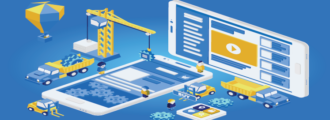Modernizing legacy systems is crucial for staying competitive and efficient in today’s rapidly evolving business landscape. This article highlights a remarkable customer journey from JD Edwards World to Oracle Fusion Cloud ERP, showcasing how one organization successfully navigated the complexities of migration to embrace a cutting-edge cloud solution.
By transitioning to Oracle Fusion Cloud ERP, the company not only streamlined business processes and enhanced scalability but also unlocked a suite of advanced features and capabilities. Read on to learn about this migration’s strategic motivations, key challenges, and transformative outcomes, offering valuable insights for businesses considering a similar leap into the future of ERP modernization.
Choosing the Right ERP Software
Our global machinery and manufacturing client went live on JD Edwards World in 1997 and has since been navigating complex customizations in virtually every corner of their production environment and awaiting the ever-anticipated end of premier and extended support for the system. While JD Edwards doesn’t plan to end extended support for World customers until May 2025, this customer decided to stay ahead of the game and proactively switch to a modernized ERP before support officially ended.
After running JD Edwards for more than 20 years, choosing a new ERP system was a decision that was not taken lightly. From considering the number of available internal staff and tapping into external consulting resources for additional support to broadening their migration scope to consider longer-term goals and understanding how to connect everything in one ecosystem, the migration team had its fair share of challenges in choosing the best-fit system.
JD Edwards EnterpriseOne
While the move to JD Edwards EnterpriseOne was the most natural transition, given the company’s extensive background in the JD Edwards landscape, knowing an end date was already in sight ultimately deterred them from choosing JDE’s cloud offering.
Infor
Infor offered the right capabilities and support to help our client navigate the migration process from JD Edwards World and streamline enterprise efficiency in the cloud. However, with headquarters outside of the United States and a lack of domestic support options, they decided to forego the switch to Infor.
Microsoft Dynamics
When considering new ERP offerings, Microsoft Dynamics could supply the right functionality the client needed, but required a subscription to a third-party software to access the whole suite. They ultimately decided against Dynamics in an effort to keep everything they needed in one system to streamline business process management and improve efficiency.
SAP
As one of the last contenders, SAP made it quite a difficult choice for the client’s internal team, offering modernized ERP functionality and cloud connections that supported a broad spectrum of enterprise management needs. While the client did have some internal experience with SAP systems, they chose a different route to keep everything integrated into one system.
Oracle Fusion Cloud
The winner! While the other ERP solutions in consideration provided the right functionality, support, and tools to successfully migrate data from the client’s outdated JD Edwards system and drive future modernization initiatives, Oracle Fusion Cloud ERP ultimately won the fight.
The client implemented Oracle CPQ in 2017, so their experience with the Oracle landscape and visualization of integrating everything into one system was the deciding factor. They began their ERP migration project in 2019 and went live on Oracle Fusion in 2023.
Navigating the Implementation Process
“If you follow the rules, do your testing and validation, and only use customizations where necessary, the migration process should be relatively easy.”
Before beginning the transition to a new Oracle Fusion Cloud system, our client evaluated their initial JD Edwards implementation process and made note of key areas of improvement for this go around. Partnering with a managed services firm and tapping into the internal knowledge of their migration team helped the client understand what they wanted to do in the new system and how to best accomplish their goals in the Oracle Cloud environment.
The client decided on a phased approach, implementing Oracle HCM first and following with EPM and Consolidation modules to maintain an effective migration plan and ensure adequate change management initiatives across their complete enterprise landscape. By implementing Oracle HCM first, each employee already had a profile and access based on their individual roles at Go-Live, making it much easier to get everyone involved and ensure a smooth transition across the board.
What went well?
As the client navigated the transition to a new Oracle Fusion system, they found a lot of areas that weren’t previously available in JD Edwards to help them gain insights into key operations, automate time consuming manual tasks, and manage standard and custom configurations in one, unified platform.
Oracle Fusion Cloud ERP made it easier for the client to:
- Access pre-built templates for data conversion and migration initiatives
- Leverage different methods to identify customers, parts, and other key data
- Streamline the data migration and validation process with pre-built tools
- Limit the amount of customization needed to improve efficiency for regular updates
What could’ve been better?
In their previous JD Edwards World system, the client’s customer and vendor master data was very messy, and complex customizations in virtually every area of the system made it difficult to execute efficient data cleanup processes.
“It was a huge shift for us to actually have good data. We’d just always done the best we could with the data we had, so focusing on data cleanup early in the process really helped us.”
While the client was able to execute more effective data cleanup for their new Oracle Fusion system, they realized that it would’ve been easier and more efficient if they had completed all core cleanup tasks before their Go-Live date. By not cleaning the data beforehand, it cost our client multiple weeks spent sifting through obsolete objects from their JDE system and ensuring all data was cleared for their respective production environments.
Understanding New Oracle Cloud Capabilities
Moving to Oracle Fusion Cloud provided our client with enhanced functionality and a broader range of tools, significantly improving operational efficiency and enhancing engagement across their entire IT landscape. The transition to the Oracle Cloud enabled streamlined processes, better resource management, and access to advanced analytics and automation features.
Here are a few key examples of efficiencies seen through their Oracle Fusion migration:
Human Capital Management
- Automated onboarding and hiring processes for new employees
- Simplified job requisition creation and approval process
- Streamlined workflows and approval processes for accelerated hiring timelines
- Manager access to all team information, including training, certificates, goals, journeys, and more
- Employee access to individual information on any device
- Self-service tools for enhanced visibility, efficiency, and performance across teams
Accounts Payable Automation
- Automation for core accounts payable processes, including entry, analysis, and approval
- Intelligent three-way match functionality for inventory items
- Automated holds for further verification on items that don’t match in the system
- Elimination of manual invoice entry and emails and phone calls to check on order/payment statuses
New Hires
- Easier to find new employees with Oracle experience than JD Edwards experience
- Reduced training time with self-service tools and enhanced system visibility
- Less time spent manually consolidating employee data and writing reports with separate reporting tools
- Simplified system training for new hires through Oracle’s fully integrated cloud landscape
- Quicker onboarding without requiring intensive training for JD Edwards and company operations
Things to Consider for an Oracle Fusion Cloud ERP Implementation
Here are a few things to consider to ensure a successful Oracle Fusion migration process:
- Data migration and integrity:
- Ensure accurate and complete data transfer
- Validate data quality and integrity post-migration
- Conduct data cleanup before Go-Live
- Customization and integration:
- Assess existing customizations and their compatibility with Oracle Fusion Cloud
- Plan for integration with other systems and third-party applications
- Only build customizations where necessary to avoid future complexities
- System infrastructure and requirements:
- Evaluate hardware and software requirements for the new cloud environment
- Ensure network readiness and security measures are in place
- Consider requirements for additional third-party installations and support tools
- Support services:
- Evaluate the level of support and professional services provided by Oracle
- Establish a strong partnership with Oracle partners and client-side consultants
How Can We Help?
Whether you need help outlining a plan for new Oracle migration projects, conducting functional testing and validation for complex configurations, implementing core security considerations, or just maintaining effective communication routes across project teams, Surety Systems is here to help.
Our senior-level Oracle consultants have the knowledge, skills, and experience to understand your needs and ensure your internal teams are prepared for continuous innovation over time.
Contact Us
Interested in learning more about our Oracle consulting services or how our team can help you successfully migrate to Oracle Cloud applications? Contact us today for more information.




